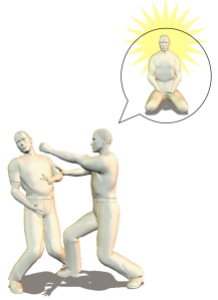Best Karate Training Focuses the Eyes
In the best Karate Training drills one should look their opponent in the eyes. This is a very interesting and powerful aspect to Karate training, so let me give you some data about it.
First, I have had a lot of people, during karate drills, ask me where they should look. The common answer that I have found over the years, and this is from Karate school to Taekwondo school to whatever Martial Arts school (style) you are studying, is that you should ‘unfocus’ your eyes on the chest. Look at the center of the body and become aware of all the stuff on the outside.
This actually isn’t bad instruction, you want to see everything, but it stops forward progress for the martial artist at a certain point.
The real advice, if you want to experience the best karate training drills, is to look at the eyes.
The eyes are the windows to a man’s soul; look at the eyes long enough…and you can actually see what a man is thinking.
Look at the body, and you stop looking at the mind, and the martial art becomes a thing of reaction, or, at the very least, slow progress.
So you look at the eyes, train hard, do your forms for discipline, and eventually you will actually pick up on the very thought of the opponent.
Tell me this doesn’t give an incredible edge in combat…to know what an opponent is thinking!
Anyway, the point is this: you can’t fight what you can’t face.
And, as you progress, if you don’t look to the eyes, attempt to see the thought behind the action, then you wo’t make the jump from fighting to handling.
You see, in the real martial arts you learn to fight so you can give up fighting.
You don’t look at an opponent and fight him, you predict what he is going to do by reading his thoughts, and then making moves that undo him rather than harm him.
Can anybody spell the word ‘harmony?’
Only idiots fight all their lives. Smart martial arts students, people who want to experience the best karate training drills, watch the eyes and learn to read the mind.
And, eventually, they experience harmony, and greater control.
Opponents become as children, and as easily handled.
And that is why, when it comes to the best karate training drills, the eyes have it.
Check out this great article on Aikido style throws. Or, you could take a look at this course presenting a more combat Aikido style.




















